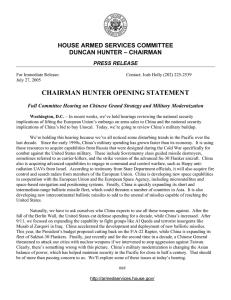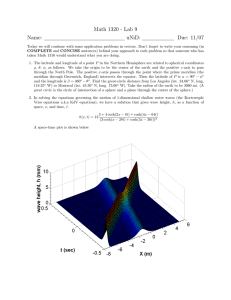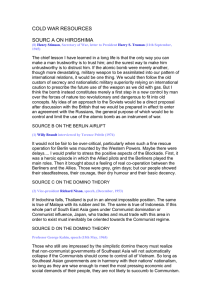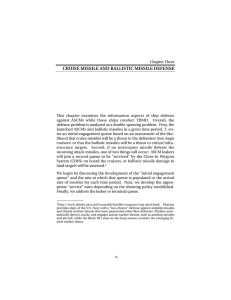ACRONYMS AND TERMS
advertisement
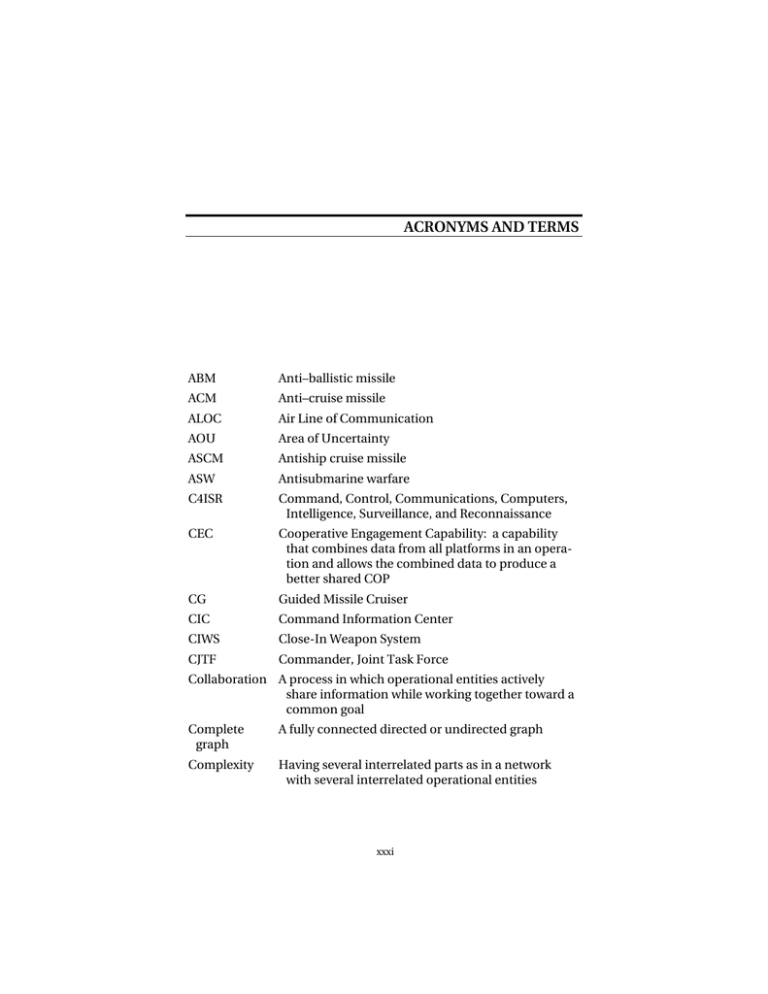
ACRONYMS AND TERMS ABM Anti–ballistic missile ACM Anti–cruise missile ALOC Air Line of Communication AOU Area of Uncertainty ASCM Antiship cruise missile ASW Antisubmarine warfare C4ISR Command, Control, Communications, Computers, Intelligence, Surveillance, and Reconnaissance CEC Cooperative Engagement Capability: a capability that combines data from all platforms in an operation and allows the combined data to produce a better shared COP CG Guided Missile Cruiser CIC Command Information Center CIWS Close-In Weapon System CJTF Commander, Joint Task Force Collaboration A process in which operational entities actively share information while working together toward a common goal Complete graph A fully connected directed or undirected graph Complexity Having several interrelated parts as in a network with several interrelated operational entities xxxi xxxii Measures of Effectiveness for the Information-Age Navy COP Common operating picture: a view of the battlespace shared by all friendly forces CVBG Carrier battle group CVIC Carrier Intelligence Center Directed Graph A graph for which the direction of the edges connecting two nodes is considered EDA Exploratory data analysis Directed Edges Of a directed graph: arcs depicting direction of information flow between nodes; also referred to as “directed connections” EW Electronic warfare Exploratory Analysis The analysis of a large set of outcomes produced by varying input parameter sets FIFO First-in-first-out queue discipline GPS Global Positioning System Graph A collection of nodes and connecting edges used to represent a network Indegree of a Node The number of edges that have that node as their terminal node Information Entropy A measure of the average amount of information in a probability distribution. Also referred to as Shannon Entropy Information Superiority The ability to collect, process, and disseminate information as needed; anticipate the changes in the enemy’s information needs; and deny the enemy the ability to do the same INS Inertial Navigation System IPB Intelligence Preparation of the Battlespace ISMWG Information Superiority Metrics Working Group ISR Intelligence, Surveillance, and Reconnaissance JTFC Joint Task Force Commander Kilo NATO designation for a Russian Project 877 DieselElectric Submarine Acronyms and Terms xxxiii Knowledge Accumulated and processed information wherein conclusions are drawn from patterns. In this report measured as normalized information entropy. See mathematical glossary below LACM Land-Attack Cruise Missile Leakers In this context, enemy missiles that elude friendly defense systems. Measures Standards for comparison. Metrics Mathematical expressions that evaluate both the relative effect of alternatives and the degree to which one is better or worse than another. MODLOC Miscellaneous Operational Details Local Operations: fixed, geographically defined operating areas MOE Measure of Effectiveness MOP Measure of Performance NCO Network-Centric Operations NCW Network-Centric Warfare ONR Office of Naval Research OOC Out of Commission Polling Request from a central authority for information essential to selecting one of several candidates to execute a mission ROF Ring of Fire (network-centric approach to littoral warfare) SAM Surface-to-Air Missile Saturation A condition occurring when the number of attacking missiles overwhelms the friendly defenses SLAM-ER Standoff Land-Attack Missile–Extended Response SLOC Sea Line of Communication SM Standard missile SS Attack submarine SSN Nuclear-powered attack submarine xxxiv Measures of Effectiveness for the Information-Age Navy SSPH Single-Shot Probability of Hit SSPK Single-Shot Probability of Kill Task Force The nodes in the network actively engaged in the operation TBM Theater (or Tactical) Ballistic Missile TBMD Theater Ballistic Missile Defense TCT Time-Critical Target TEL Transportable-Erector-Launcher UCAV Unmanned Combat Aerial Vehicle V/STOL Vertical/Short Takeoff and Landing GLOSSARY OF MATHEMATICAL TERMS This glossary records the more important mathematical terms used in the report. The chapter reference is included because the same term may have different meanings in each chapter it appears. Term A(b ) Definition Designation for Aegis cruiser directing its SPY-1 radar to detect and track ballistic missiles Chapter Reference 3 A(c ) Designation for Aegis cruiser directing its SPY-1 radar to detect and track cruise missiles 3 nc , nb The total number of launched cruise missiles and ballistic missiles, respectively, that are scheduled to “arrive.” 3 T = τt T is the total CM/BM attack time (in minutes) and τ is the number of attack time periods of duration t 3 λci , λ bi The average arrival rates per minute in time period i for cruise and ballistic missiles, respectively 3 xxxv xxxvi Measures of Effectiveness for the Information-Age Navy λ̂ ci , λ̂ bi The estimated average arrival rates per minute in time period i for cruise and ballistic missiles, respectively g = λ ct , g = λ bt The number of cruise and ballistic missiles, respectively, arriving in a time period 3 3 pc The single-shot probability that a Standard missile intercept from an Aegis cruiser kills an attacking cruise missile 3 PK The effective probability that a Standard missile interceptor will kill an attacking cruise missile 3 PL = 1 − PK The probability that an attacking cruise missile will be a “leaker” 3 Li = PL λci t The expected number of leakers in time period i 3 Ef The expected number of Standard missiles that must be fired at each attacking cruise missile 3 h The number of attacking cruise missiles detected at a given time 3 The mean time required for each Aegis cruiser to engage an attacking missile: τ1 is the mean time to prepare a launcher, τ2 the mean time required to launch the intercept, and τ 3 the mean time to fly out to the target 3 The time required to prepare a Standard missile launcher for the next launch 3 µ= 1 τ1 + τ 2 + τ3 δ = τ1 + τ2 Glossary of Mathematical Terms xxxvii NL The number of attacking cruise missiles required to destroy an Aegis cruiser 3 V 0 (x ), V 1(x ) , The maximum or target variance and the minimum variance, respectively, for the fraction of remaining missiles arriving in the current time period 3 and Appendix A H(x) H (x ) = E [ln( f (x ))] = − ∫−∞ ln[ f (x )]f(x )dx Information or Shannon entropy. See Acronyms list for definition 3 K (λ ) The degree to which the attacking missile arrival rate is known. Calculated as the normalized H (λ) . 3 δc , δ b The minimum number of ACMs and ABMs needed to assume the role of defense against CMs and BMs, respectively 3 I c(c) , I b(c) The remaining inventories of ACMs and ABMs on board A(c ) 3 I c(b ) , I b(b ) The remaining inventories of ACMs and ABMs on board A(b ) 3 Ef The number of Standard missiles required to destroy an enemy missile (f = c implies ACM and f = b implies ABM) 3 Ff Estimate of the future attack (f = c implies CM attack and f = b implies BM attack) 3 d (fc ) The number of Standard missiles A(c ) should launch against attacking enemy missiles of type f (f = c implies CM attack and f = b implies BM attack) 3 ∞ xxxviii Measures of Effectiveness for the Information-Age Navy d (fb ) The number of Standard missiles A(b ) should launch against attacking enemy missiles of type f (f = c implies CM attack and f = b implies BM attack) 3 E c ( c ), E c ( b ), The expected number of ACMs fired by A(c ) , A(b ) , or both 3 The expected number of ABMs fired by A(c ) , A(b ) , or both 3 1/ λi The mean time required to accomplish task i. 4 L , Lc , LcC The network latencies: base, with collaboration factored and with both collaboration and complexity factored 4 E c ( b, c ) E b ( c ), E b ( b ), E b ( b, c )
